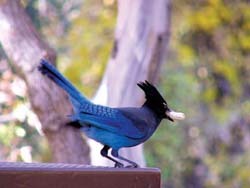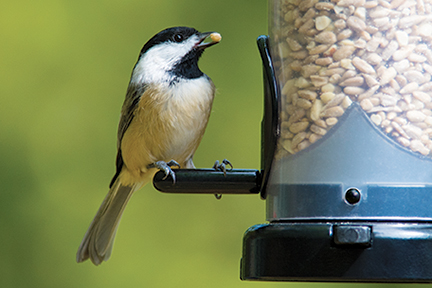Bird of the Month: Steller's Jay
Steller's Jays are large songbirds with large heads, chunky bodies, rounded wings and a long, full tail. Their bill is long, straight and powerful. They have a prominent crest that often stands nearly straight up from their head.
Steller's Jays are very dark birds. The head is black and the body is blue. The lightest blue is on the wings. They have white markings above their eyes that are fairly inconspicuous.
Steller's Jays are bold, inquisitive, intelligent and noisy.They are social birds traveling in groups and sometimes playing with each other or chasing each other. They move by hopping on their long legs and at times, cocking their heads in order to observe their surroundings.
Steller's Jays are found in the evergreen forests of western North America. They are often seen at campgrounds, picnic areas, parks and backyards.
Steller's Jays eat insects, seeds, berries, nuts, small animals, eggs and nestlings. They will come to feeders for peanuts, sunflower seeds and suet. They will also eat garbage and unguarded picnic items. Because these birds have excellent spatial memories, they will often bury food items such a whole peanuts for a winter food source.
The nest of the Steller's Jay is a bulky cup of stems, leaves, moss and sticks held together with mud. The inside is lined with pine needles, soft rootlets or animal hair. Both members of the pair choose the nest site and both gather nest material. The nest is built on a horizontal branch close to the trunk and often near the top of a conifer tree.
The female will lay 2 - 6 eggs that will be bluish-green with dark brown, purple or olive spots. She will sit on them for 16 days. After the eggs hatch, the chicks will leave the nest after another 16 days.
Other cool facts:
Steller's Jays and Blue Jays are the only North American jays with crests.
Steller's Jays have the most frequently misspelled names in all of bird watching. They are named after Georg Steller, a naturalist on a Russian explorer's ship, who discovered them on an Alaskan island in 1741. He also discovered the Steller's Sea Lion and the Steller's Sea Eagle.
The Steller's Jay and the Blue Jay are the only New World jays that use mud to build their nests.
The Steller's Jay shows a great deal of variation in appearance throughout its range with some populations featuring black crests and others blue.
Steller's Jays are habitual nest robbers.
The Steller's Jay can imitate other birds, squirrels, cats, dogs, chickens and some mechanical objects.
The oldest recorded Steller's Jay was a male at least 16 years 1 month old. He was found in Alaska in 1987 and had been banded in that same state in 1972.

